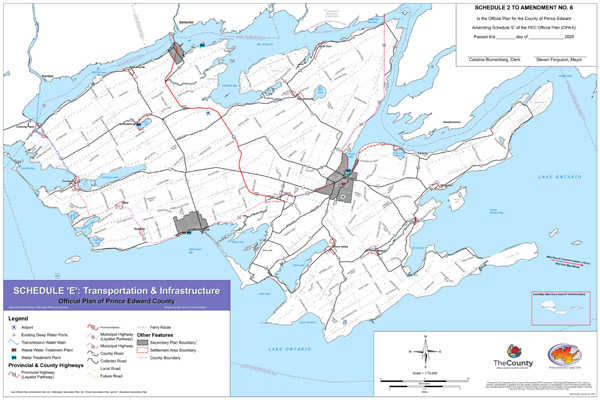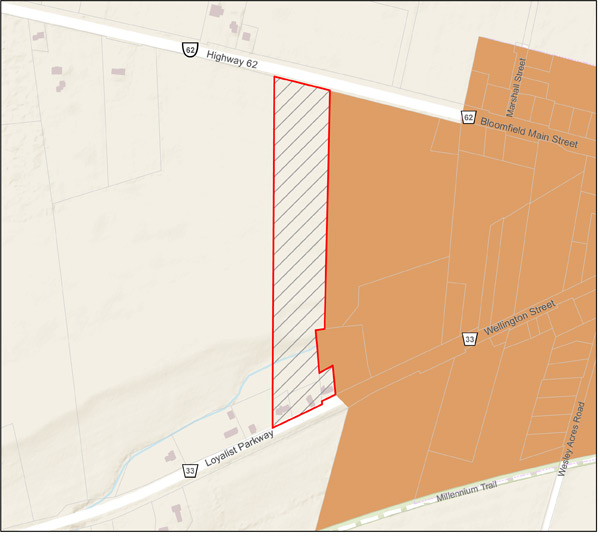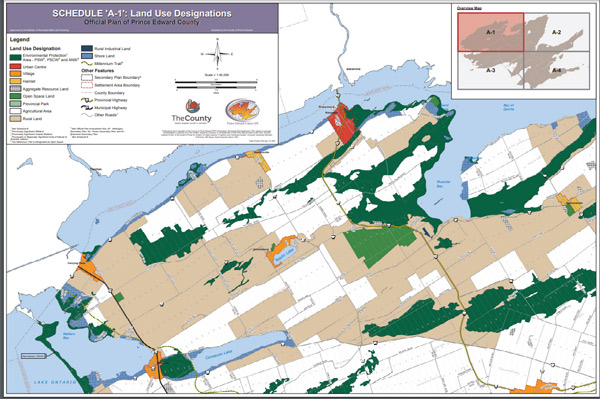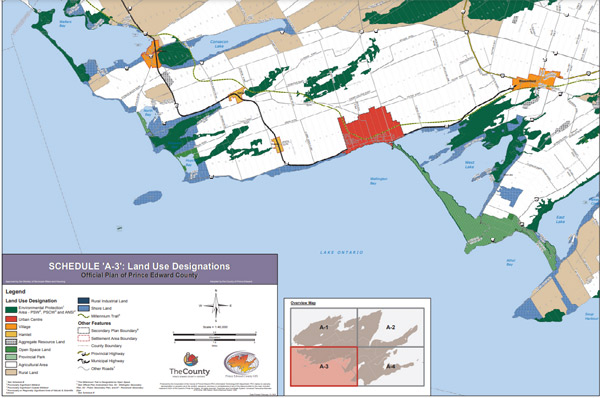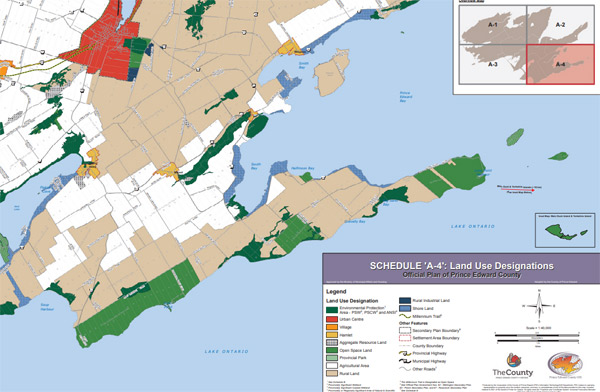Additional dwelling units, employment areas among Official Plan proposed updates
Administrator | Feb 07, 2025 | Comments 0
By Sharon Harrison
A long list of proposed updates to the County’s official plan – some at the discretion of the municipality, and others provincially-driven – are largely to align with the 2024 provincial planning statement (PPS), the Ontario government’s policies on land use, updated in 2024 to focus on building more homes.
Details include the development of an agricultural system, changes to employment areas, (economic activities) recognizing the commercial fishery and heritage conservation districts, allowing settlement area boundary changes, additional dwelling units in rural areas, as well as changes for review of the official plan.
In the new format two-part statutory planning procedure, the purpose of the first overview meeting is for staff to gather information and is largely intended to provide more opportunity for the public to participate. Decisions by council are to happen at a second public meeting (expected March 5). The clerk indicated members of council may make brief comment and ask basic questions at the first meeting, but anything substantial cannot be discussed or debated until the second meeting. Nevertheless, extensive discussion and debate among council did ensue Wednesday.
Scott Pordham, the County’s policy co-ordinator, provided an outline of the changes in his presentation at Wednesday’s special planning and development statutory public committee meeting which was re-scheduled from Jan. 22.
Referred to as amendment No. 6, the purpose of the various proposed amendments is to ensure consistency with the new (2024) provincial planning statement, but also to address changes made to the planning act and Ontario regulations, along with making general amendments to address local needs.
 The list of proposed changes includes things such as recognizing the approved Picton Main Street Heritage Conservation District and the new Wellington Heritage Conservation District with the addition of a new policy. “That way, new development would need to comply with the requirements of those heritage conservation districts.”
The list of proposed changes includes things such as recognizing the approved Picton Main Street Heritage Conservation District and the new Wellington Heritage Conservation District with the addition of a new policy. “That way, new development would need to comply with the requirements of those heritage conservation districts.”
The development of an agriculture system intended to protect agricultural lands and assets is also part of the changes. Another update includes transportation and infrastructure to identify existing and approved roads in Picton, Wellington, and Rossmore
“For some reason, it did not show the existing road networks, so we are looking to add it, and as well any roads that were approved through a sub-division approval, they would be identified as well. It won’t include a road that is being considered as part of the Picton transportation master plan.”
The proposed changes include expanding the west side of the Bloomfield village boundary slightly to match existing lot lines. The area includes three small residential lots along Loyalist Parkway.
“The current boundary for the village runs through a property, so approximately two-thirds of it is within the village boundary, and a third of it is outside of it,” explained Pordham.
He described it is a narrow strip approximately 100 metres wide that is outside of the boundary, where the proposal is it be brought into the Bloomfield boundary as a measure to “eliminate any deterrent for anyone who might want to develop that property that is already in the boundary”.
Councillor Brad Nieman asked for an explanation of the changes pertaining to allowing settlement area boundary changes outside of a comprehensive review, and to permit changes to employment areas outside of a comprehensive review.
Under the former 2020 provincial policy statement, municipalities could only expand their urban boundaries at the time of a comprehensive review, which would have been done every five or 10 years, outlined Pordham. “Now, if a municipality decides they would like to expand the urban boundary, the decision is still of council’s, it is still an application that comes forward to council, and it’s a decision at your discretion.”
He further noted it can be done at any time, ensuring some flexibility for municipalities to accommodate something that maybe comes up prior to the need for a comprehensive review. “That’s something the province has built in to provide some flexibility for municipalities, and a third-party submission could be submitted, but it’s still a council decision.”
Regarding employment areas, proposals will permit changes to employment areas outside of a comprehensive review, but subject to criteria, along with a requirement for the municipality to consider a buffer or mitigation measures before identifying new employment areas.
“If you can’t provide the 300-metre buffer, then you need to look at providing mitigation measures to ensure that the lands can be used for employment purposes without negatively impacting surrounding land uses,” said Pordham.
He noted the new requirement doesn’t affect existing employment areas. He gave the example that if the County was looking at identifying a new industrial park, it would have to look at either providing that buffer, or providing mitigation measures.
Councillor Nieman asked if the 300-metres is from all or existing sub-divisions or residential areas, as well as proposed, to which Pordham confirmed if there is existing development in close proximity to a new industrial employment area, mitigation measures can be looked at.
He said those could include traffic, noise,or dust that might be generated from the new employment area. “It wouldn’t be uncommon that you are not going to meet the 300-metres, but there are mitigation measures that could be introduced to help, so that you are not having negative impact.”
In a question from councillor Janice Maynard, establishing if this was just for industrial (not commercial, warehousing, light industrial or similar categories), Pordham explained how this is something different.
“It used to be that employment areas might include commercial or institutional uses, but with the change in the provincial policy, they are defining it a little more tightly that it is industrial lands. So it could include manufacturing, whether it’s light or heavy industrial, warehousing, those sorts of uses.”
Councillor David Harrison said, “In effect, if there was an industry that came in, that would sterilize the land for a 1,000 feet on each side of that”, to which Pordham replied, not necessarily.
Pordham said, they look first for the municipality to at least look at the 300-metres, but if mitigation measures can still accomplish protecting the industrial lands, and the protection of the other sensitive lands uses that might be nearby, just to avoid that land-use conflict, there may be measures that could allow for a closer proximity of those industrial lands and, say, residential lands.
He gave examples of things like berms or vegetative buffers, things of that nature might be used to reduce noise or other factors.
“My concern is, if there weren’t the ways and means to accommodate that, it would be a tremendous burden to the adjoining landowners because they couldn’t do anything with their land without these measures that you assure that could happen,” added Harrison.
Another proposed change to the OP will permit two additional dwelling units in the rural areas.
In a question from councillor Harrison about severance, Pordham confirmed his understanding that adding an additional house to a lot would retain the same title of land.
“The policy allows for additional dwelling units, but doesn’t envision them being severed,” confirmed Pordham. “So, if somebody wants to sever their property to allow for a new home, we need to make that choice up-front because otherwise the additional dwelling unit would be remaining with the primary dwelling on one lot.”
Councillor Phil St-Jean asked how that would apply to an existing farm, as he said that’s where it’s going to have the biggest impact, if somebody wants to build a secondary dwelling or provide an additional dwelling on their farm lot.
“I am having difficulty in how MDS (minimum distance separation) is going to come into play there –and does it, because you’ve already got an existing residential unit?” asked St-Jean. “It’s pretty difficult to include two houses in one and then build a secondary one on a one-acre lot. How is this going to come into play, and how is MDS going to affect that?”
Pordham explained that when they are looking at additional dwelling units, the policy speaks to having one new building and then the second one can be within one of those units, so a basement apartment, for instance, which would be allowed.
“Obviously, with a one-acre lot there is less room to accommodate additional dwelling units, but it may be possible. We would be looking at, as part of this process, we would be looking at an adequate water supply there.”
Councillor St-Jean continued wondering how MDS would work, or if it would have anything to do with this.
“None of it is clear, not the provincial planning statement, not the planning act,” he said.
“We know farmers can sever lots for family still, but if they don’t want to sever, if they want to put an addition on the existing house and put an additional home on the one-acre, it becomes really problematic,” expressed St-Jean. “It doesn’t make sense. I’m struggling with how unclear this is and how unworkable it probably could be. I want to allow farmers to have multi-generational housing on their property. I don’t know how this is going to work, and I’m not happy about it.”
Pordham further outlined how the intent of the policy change is to foster development of new homes, given the housing shortage, and especially for affordable units.
Clarifying the earlier MDS question, Pordham said the zoning bylaw has a requirement additional dwelling units have to be in close proximity to the main dwelling.
“It’s not like you are going to create a situation where you are going to have a house in one location and this additional dwelling unit be well away. They are going to be clumped together to try and keep those residential uses close.”
He said, under the PPS, they do have to comply with MDS, to which St-Jean said, “that’s where it going to be challenging”.
St-Jean said that MDS was to ensure the “long-term viability, and protect the farmer from undue restrictions. I think it’s not well thought out from the province’s side”.
Pordham said the policy is targeting new employment areas.
“If the County were looking at identifying a larger area, a new industrial park for instance, that’s when the policy would be in considered,” he explained. “Individual proprieties that someone might want to re-zone in one of the smaller communities, hamlets for instance, maybe Consecon of Carrying Place, that’s still a possibility, it’s not an employment area as identified in the OP.”
The proposal also includes the requirement for a review of the official plan 10 years after it was passed, and every five years afterward, until a new official plan is adopted.
“It is a change from the previous requirement which was to review it every five years, so it gives it a little more time on that first review after the plan was passed,” said Pordham. “With our plan being passed in 2021, under the act we are supposed to have it reviewed by the new date of 2031.”
The policy change requires new lots on private services to be serviced by one single on-site private well, not multiple wells, and an on-site sewage system.
“Obviously, we are aware that existing development might be serviced by multiple wells or cisterns, and that’s fine, but if someone is creating a new lot, we want to make sure there is an adequate water supply from one source,” said Pordham. “We don’t want to see that it has to be serviced by multiple wells because perhaps the water yield from one or two wells isn’t enough to service a house on a new lot.”
The presence of the commercial fishery, and its contributions to the County, is also recognized with various policy amendments to the official plan, specifically to provide policy direction when considering development for proposals related to the commercial fishery.
One member of the public, Rosalind Adams, spoke at length on the initial proposed amendments as they relate to the commercial fishery, indicating how she found the changes overall “inadequate and nonsensical”.
“They did not recognize the historical, cultural, ecological, food security and economic value of the County’s commercial fishery. They confuse fishing with agriculture and they attempted to cram a long list of sport fishing amenities that have nothing to do with commercial fishing or agriculture and to the agriculture system,” outlined Adams.
Working with Pordham, she indicated how the further changes now “recognize the value of the commercial fishery and protection through the OP that really capture what we were seeking”.
She also spoke to the proposal to bring commercial fishing into the OP under the shoreland designation.
“They recognize the presence of the fishery in the shoreline community and to ensure access to Bay of Quinte and Lake Ontario for the commercial fishery.”
She said the proposals relating to this all recognize the value of and protect the future of the County commercial fishery in tandem with County agriculture. “The words capture exactly what we were after, providing the fishery with the same protection and support that the OP gives agriculture, while recognizing the fishery as a distinct entity.”
Filed Under: Featured Articles • Local News
About the Author:



